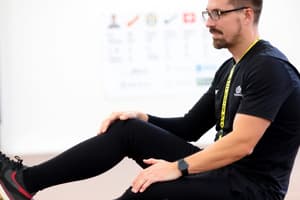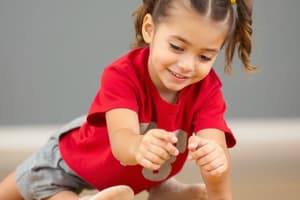Podcast
Questions and Answers
What are gross motor skills primarily involved with?
What are gross motor skills primarily involved with?
- Fine motor tasks such as sewing and writing
- Mental processes related to motor control
- Large muscle groups used in movements like running (correct)
- Small muscle groups used in intricate tasks
Which of the following is a standardized test for assessing motor skills in children?
Which of the following is a standardized test for assessing motor skills in children?
- Direct Observation Method
- Self-Assessment Survey
- Peabody Developmental Motor Scales (PDMS-2) (correct)
- Performance Tasks Evaluation
What is a key consideration when assessing motor skills?
What is a key consideration when assessing motor skills?
- Age and developmental stage of the individual (correct)
- The complexity of the task being evaluated
- Availability of advanced technology
- Self-assessment of personal skills
Which method involves direct observation of an individual's performance?
Which method involves direct observation of an individual's performance?
What is one application of assessing motor skills in education?
What is one application of assessing motor skills in education?
Flashcards are hidden until you start studying
Study Notes
Motor Skill Assessment: Measuring Movement
- Motor skills are essential for interacting with our environment, ranging from simple movements to complex actions.
- They are assessed for various purposes, including early intervention, rehabilitation, performance optimization, and research.
Types of Motor Skills
- Gross motor skills involve large muscle groups, such as running and jumping.
- Fine motor skills involve smaller muscle groups, such as writing and sewing.
Assessment Methods
- Standardized Tests: Objective assessments used to evaluate motor skills, often used in clinical and educational settings.
- Peabody Developmental Motor Scales (PDMS-2): Assesses gross and fine motor skills in children.
- Bruininks-Oseretsky Test of Motor Proficiency (BOT-2): Evaluates motor proficiency in children and adolescents.
- Observation: An expert observes an individual performing tasks to assess coordination, balance, and agility. Checklists and rubrics guide the process.
- Performance Tasks: Specific activities like throwing a ball or balancing on one foot, tested under controlled conditions.
- Technology-Assisted Assessments: High-tech tools for movement analysis.
- Motion capture systems: Analyze movement patterns in 3D.
- Wearable devices: Accelerometers and gyroscopes monitor physical activity and movements.
- Self-Assessment and Peer Assessment: Questionnaires and surveys gather insights into perceived skill levels. Peer evaluations are used in group activities.
Key Considerations
- Age and Development: Assessments should be age-appropriate as motor skills develop progressively.
- Context: Assess skills in familiar and unfamiliar environments to understand adaptability.
- Frequency: Regular assessments track progress and inform interventions.
Applications
- Education: Informs curriculum design in physical education.
- Rehabilitation: Evaluates progress in therapy and recovery plans.
- Sports: Identifies strengths and weaknesses to improve training programs.
Methods for Measuring and Assessing Motor Skills
- Observational Assessments: An expert observes and evaluates performance based on criteria.
- Advantages: Assesses complex real-world skills, provides insights into movement quality and efficiency.
- Disadvantages: Subjective, relies on expertise, time-consuming.
- Performance-Based Tests: Standardized tasks with objective performance measurement.
- Advantages: Provides quantifiable data, allows comparison, standardized and reliable.
- Disadvantages: May not reflect real-world performance, limited in assessing complex skills.
- Physiological Measures: Specialized equipment measures physiological responses related to motor skills.
- Electromyography (EMG): Measures muscle electrical activity.
- Motion Capture: Tracks 3D body movements.
- Force Plates: Measure ground reaction forces during movement.
- Advantages: Detailed information about motor control mechanisms, objective and quantifiable data.
- Disadvantages: Requires specialized equipment and expertise, not feasible in all settings.
- Self-Report Measures: Individuals rate their skills through questionnaires or surveys.
- Advantages: Provides subjective insights into self-perception, easy to administer.
- Disadvantages: Subjective, influenced by self-confidence, potential bias.
Studying That Suits You
Use AI to generate personalized quizzes and flashcards to suit your learning preferences.




